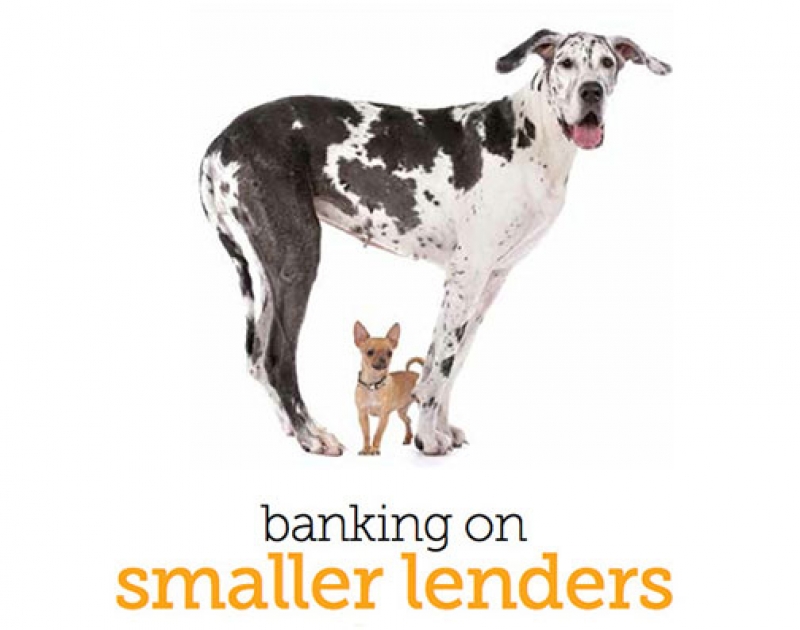Whether we realize it - or care to admit it - Australians are very loyal to our big banks. In fact, more than 80 per cent of home loans in Australia are held by one of the big four or their subsidiaries. But there are other options out there in the form of non-bank lenders. Haven takes a look at how non-bank lenders work and what they can and can't offer home owners.
What is a non-bank lender?
The term non-bank lender is a little confusing because it implies any financial institution that isn’t a bank, such as a credit union or a building society, falls into this category. The term broadly covers financial institutions that only deal in loans and do not hold deposits. A building society, for example, where you can have a loan product and a savings account, is technically lumped in with banking lenders. However, most consumers would consider a credit union or a building society to be bank alternatives.
How do they work?
Because non-bank lenders don’t hold deposits, they have to rely on other sources of funding for their loans. While all lenders borrow money on the wholesale market, non-bank lenders have to rely solely on this funding stream. Banks, credit unions and building societies, on the other hand,
are able to prop up their lending to some extent with the funds from customers’ savings. This distinction is important because it affected non-bank lenders’ ability to weather the GFC, and why their market share fell from around 12 per cent before the crisis to around just 2.5 per cent afterwards.
But non-bank lenders have bounced back and are being sought by many consumers as an alternative to traditional lenders, largely due to the post-GFC support of the Australian Office of Financial Management. Realizing the importance of creating competition in the home loan market, the Federal Government decided to invest in home loans, creating a safety net for non-bank lenders. So supportive is the government of this increased competition, Treasurer Wayne Swann last year declared non-bank lenders the fifth pillar of our financial system.
Are they safe?
The GFC raised concerns about the flow-on effects of financial institutions who went belly up because they failed to manage their loan portfolios. Here in Australia, banks and other institutions that take deposits are regulated by the Australian Prudential Regulation Authority, while non- bank lenders come under the scrutiny of the Australian Securities and Investments Commission, which can intervene if you feel a lender has acted illegally.
All consumer credit products, including home loans, are governed by the Uniform Consumer Credit Code, which ensures lenders make borrowers aware of their rights and obligations and put sufficient checks and balances in place to ensure borrowers can repay their loan.
At the end of the day, if a lender folds, there is minimal risk to borrowers because the mortgage will be taken up by another lender. If you’re not happy with that lender, the ban on exit fees means you can take your business elsewhere.
Advantages of non-bank lenders
Better rates
Despite what many consumers may think, non-banks are usually able to offer lower standard rates. This is because they are looking for ways to claim market share and generally operate with lower overheads than banks. They are also usually not publicly-listed entities, so are not under the scrutiny of investors anticipating dividends or increased share prices.
Traditionally, non-bank lenders offered lower rates and then relied on exit fees to deter borrowers from jumping ship. But since July 1, 2011, exit fees on consumer loans have been banned, curbing one of the competitive levers for non-banks.
Even though the new role was designed to drive competition, market watchers were concerned non-bank lenders would have to hike their rates if they could not charge exit fees. But any negative impacts of this change appear to have been offset by a boost to the wholesale funding market, allowing non-bank lenders to access funds at a competitive rate, which in turn benefits their customers.
More flexibility
Being leaner, non-bank lenders are often more nimble when it comes to service and responsiveness, although this can be difficult to measure. They are also often more open to consumers who have been knocked back by one of the banks due to previous credit issues or self-employment.
Disadvantages of non-bank lenders
Limited products
If you are looking to house all of your financial products with one institution, a non-bank lender may not work for you. Although they tend to offer a solid range of mortgage products, they are unable
to hold deposits, so you won’t be able to set up a transactional account and credit card with the same lender. Some non-banks do offer offset accounts by setting them up with a banking partner. The offset account acts like a savings account, where the funds reduce the balance on the loan and the amount of interest charged.
Inconsistent offerings
Because non-bank lenders have no deposits to support their loans, they often rely on a range of wholesale loans to source their funding, increasing their exposure to market fluctuations. This means the interest rate and terms offered to one customer with a non-bank lender may differ from what’s offered to another.
The simplest way to work out if a non-bank lender is right for you and your circumstances is to talk to your broker. Brokers act as a one-stop shop, with access to a wide range of lenders, including banks and non-banks, and hundreds of home loan products.


